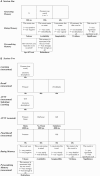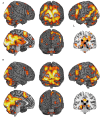Neural Correlates of Direct and Indirect Suppression of Autobiographical Memories
- PMID: 27047412
- PMCID: PMC4797753
- DOI: 10.3389/fpsyg.2016.00379
Neural Correlates of Direct and Indirect Suppression of Autobiographical Memories
Abstract
Research indicates that there are two possible mechanisms by which particular target memories can be intentionally forgotten. Direct suppression, which involves the suppression of the unwanted memory directly, and is dependent on a fronto-hippocampal modulatory process, and, memory substitution, which includes directing one's attention to an alternative memory in order to prevent the unwanted memory from coming to mind, and involves engaging the caudal prefrontal cortex (cPFC) and the mid-ventrolateral prefrontal cortex (VLPFC) regions. Research to date, however, has investigated the neural basis of memory suppression of relatively simple information. The aim of the current study was to use fMRI to identify the neural mechanisms associated with the suppression of autobiographical memories. In the present study, 22 participants generated memories in response to a series of cue words. In a second session, participants learnt these cue-memory pairings, and were subsequently presented with a cue word and asked either to recall (think) or to suppress (no-think) the associated memory, or to think of an alternative memory in order to suppress the original memory (memory-substitution). Our findings demonstrated successful forgetting effects in the no-think and memory substitution conditions. Although we found no activation in the dorsolateral prefrontal cortex, there was reduced hippocampal activation during direct suppression. In the memory substitution condition, however, we failed to find increased activation in the cPFC and VLPFC regions. Our findings suggest that the suppression of autobiographical memories may rely on different neural mechanisms to those established for other types of material in memory.
Keywords: autobiographical memories; direct suppression; fMRI; memory retrieval; think/no-think.
Figures





Similar articles
-
EEG evidence that morally relevant autobiographical memories can be suppressed.Cogn Affect Behav Neurosci. 2022 Dec;22(6):1290-1310. doi: 10.3758/s13415-022-01029-5. Epub 2022 Aug 19. Cogn Affect Behav Neurosci. 2022. PMID: 35986196 Free PMC article.
-
Neural bases of motivated forgetting of autobiographical memories.Cogn Neurosci. 2023 Jan;14(1):15-24. doi: 10.1080/17588928.2022.2136150. Epub 2022 Nov 21. Cogn Neurosci. 2023. PMID: 36409182
-
It's all in the detail: intentional forgetting of autobiographical memories using the autobiographical think/no-think task.J Exp Psychol Learn Mem Cogn. 2013 Mar;39(2):375-93. doi: 10.1037/a0028888. Epub 2012 Jun 11. J Exp Psychol Learn Mem Cogn. 2013. PMID: 22686849
-
[Episodic autobiographical memory in depression: a review].Encephale. 2006 Oct;32(5 Pt 1):781-8. doi: 10.1016/s0013-7006(06)76231-5. Encephale. 2006. PMID: 17099603 Review. French.
-
A Systematic Review and Meta-analysis of the Neural Correlates of Direct vs. Generative Retrieval of Episodic Autobiographical Memory.Neuropsychol Rev. 2024 Dec 10. doi: 10.1007/s11065-024-09653-3. Online ahead of print. Neuropsychol Rev. 2024. PMID: 39653872 Review.
Cited by
-
Obliviate! Reviewing Neural Fundamentals of Intentional Forgetting from a Meta-Analytic Perspective.Biomedicines. 2022 Jun 29;10(7):1555. doi: 10.3390/biomedicines10071555. Biomedicines. 2022. PMID: 35884860 Free PMC article. Review.
-
Memory Control: A Fundamental Mechanism of Emotion Regulation.Trends Cogn Sci. 2018 Nov;22(11):982-995. doi: 10.1016/j.tics.2018.07.015. Epub 2018 Aug 16. Trends Cogn Sci. 2018. PMID: 30122359 Free PMC article. Review.
-
Suppressing Unwanted Memories Reduces Their Unintended Influences.Curr Dir Psychol Sci. 2017 Apr;26(2):197-206. doi: 10.1177/0963721417689881. Epub 2017 Apr 6. Curr Dir Psychol Sci. 2017. PMID: 28458471 Free PMC article.
-
Investigating Behavioral and Psychophysiological Reactions to Conflict-Related and Individualized Stimuli as Potential Correlates of Repression.Front Psychol. 2017 Sep 14;8:1511. doi: 10.3389/fpsyg.2017.01511. eCollection 2017. Front Psychol. 2017. PMID: 28959219 Free PMC article.
-
EEG evidence that morally relevant autobiographical memories can be suppressed.Cogn Affect Behav Neurosci. 2022 Dec;22(6):1290-1310. doi: 10.3758/s13415-022-01029-5. Epub 2022 Aug 19. Cogn Affect Behav Neurosci. 2022. PMID: 35986196 Free PMC article.
References
-
- Anderson M. C. (2003). Rethinking interference theory: executive control and the mechanisms of forgetting. J. Mem. Lang. 49 415–445. 10.1016/j.neuroscience.2008.08.026 - DOI
-
- Anderson M. C. (2005). “The role of inhibitory control in forgetting unwanted memories: a consideration of three methods,” in Dynamic Cognitive Processes, eds MacLeod C., Uttl B. (Tokyo: Springer; ), 159–190.
-
- Anderson M. C., Huddleston E. (2011). “Towards a cognitive and neurobiological model of motivated forgetting,” in True and False Recovered Memories: Toward a Reconciliation of the Debate, ed. Belli R. F. (New York, NY: Springer; ). - PubMed
LinkOut - more resources
Full Text Sources
Other Literature Sources

